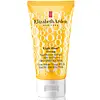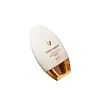What's inside
What's inside
 Key Ingredients
Key Ingredients

 Benefits
Benefits

 Concerns
Concerns

 Ingredients Side-by-side
Ingredients Side-by-side

Zinc Oxide 11.62%
Cosmetic ColorantEthylhexyl Methoxycinnamate 7.4%
UV AbsorberEthylhexyl Salicylate 5%
UV AbsorberWater
Skin ConditioningC12-15 Alkyl Benzoate
AntimicrobialIsodecyl Neopentanoate
EmollientNeopentyl Glycol Diheptanoate
EmollientMagnesium Aluminum Silicate
AbsorbentGlyceryl Stearate
EmollientPEG-100 Stearate
Caprylyl Glycol
EmollientArachidyl Alcohol
EmollientPolyhydroxystearic Acid
EmulsifyingArachidyl Glucoside
EmulsifyingTriethoxycaprylylsilane
Behenyl Alcohol
EmollientXanthan Gum
EmulsifyingBHT
AntioxidantDisodium EDTA
Parfum
MaskingCitral
PerfumingCitronellol
PerfumingGeraniol
PerfumingLimonene
PerfumingLinalool
PerfumingMethylparaben
PreservativePhenoxyethanol
PreservativeIsoamyl P-Methoxycinnamate
UV AbsorberDiethylamino Hydroxybenzoyl Hexyl Benzoate
UV FilterCyclopentasiloxane
EmollientSilica
AbrasiveMethylene Bis-Benzotriazolyl Tetramethylbutylphenol
UV FilterPotassium Cetyl Phosphate
EmulsifyingDicaprylyl Carbonate
EmollientDibutyl Adipate
EmollientBis-Ethylhexyloxyphenol Methoxyphenyl Triazine
Skin ConditioningEthylhexyl Triazone
UV AbsorberCetyl Dimethicone
EmollientTriethylhexanoin
MaskingGlycerin
HumectantAcrylates Copolymer
Oryza Sativa
Biosaccharide Gum-4
Skin ConditioningButylene Glycol
HumectantCetyl Alcohol
EmollientCyclohexasiloxane
EmollientDecyl Glucoside
CleansingDimethicone Crosspolymer
Emulsion StabilisingEthylhexylglycerin
Skin ConditioningHydrogenated Palm Glycerides Citrate
EmollientHydrolyzed Soy Protein
HumectantHydrolyzed Wheat Protein
Skin ConditioningPhenylpropanol
MaskingPropylene Glycol
HumectantSchizophyllan
HumectantSodium Polyacrylate
AbsorbentSorbitan Stearate
EmulsifyingTocopherol
AntioxidantTocopheryl Acetate
AntioxidantTriethanolamine
BufferingTripeptide-1
Skin ConditioningBenzyl Alcohol
PerfumingEthylparaben
PreservativeO-Cymen-5-Ol
AntimicrobialPropylparaben
PreservativeZinc Oxide 11.62%, Ethylhexyl Methoxycinnamate 7.4%, Ethylhexyl Salicylate 5%, Water, C12-15 Alkyl Benzoate, Isodecyl Neopentanoate, Neopentyl Glycol Diheptanoate, Magnesium Aluminum Silicate, Glyceryl Stearate, PEG-100 Stearate, Caprylyl Glycol, Arachidyl Alcohol, Polyhydroxystearic Acid, Arachidyl Glucoside, Triethoxycaprylylsilane, Behenyl Alcohol, Xanthan Gum, BHT, Disodium EDTA, Parfum, Citral, Citronellol, Geraniol, Limonene, Linalool, Methylparaben, Phenoxyethanol, Isoamyl P-Methoxycinnamate, Diethylamino Hydroxybenzoyl Hexyl Benzoate, Cyclopentasiloxane, Silica, Methylene Bis-Benzotriazolyl Tetramethylbutylphenol, Potassium Cetyl Phosphate, Dicaprylyl Carbonate, Dibutyl Adipate, Bis-Ethylhexyloxyphenol Methoxyphenyl Triazine, Ethylhexyl Triazone, Cetyl Dimethicone, Triethylhexanoin, Glycerin, Acrylates Copolymer, Oryza Sativa, Biosaccharide Gum-4, Butylene Glycol, Cetyl Alcohol, Cyclohexasiloxane, Decyl Glucoside, Dimethicone Crosspolymer, Ethylhexylglycerin, Hydrogenated Palm Glycerides Citrate, Hydrolyzed Soy Protein, Hydrolyzed Wheat Protein, Phenylpropanol, Propylene Glycol, Schizophyllan, Sodium Polyacrylate, Sorbitan Stearate, Tocopherol, Tocopheryl Acetate, Triethanolamine, Tripeptide-1, Benzyl Alcohol, Ethylparaben, O-Cymen-5-Ol, Propylparaben
Water
Skin ConditioningZinc Oxide 17%
Cosmetic ColorantC12-15 Alkyl Benzoate
AntimicrobialButyloctyl Salicylate
Skin ConditioningCaprylyl Methicone
Skin ConditioningGlycerin
HumectantDimethicone
EmollientNiacinamide
SmoothingCopernicia Cerifera Wax
Argania Spinosa Kernel Oil
EmollientTocopheryl Acetate
AntioxidantPEG-9 Polydimethylsiloxyethyl Dimethicone
EmulsifyingCapsicum Annuum Fruit Extract
AntimicrobialPolyhydroxystearic Acid
EmulsifyingDimethicone/PEG-10/15 Crosspolymer
Stearalkonium Hectorite
Gel FormingTocopherol
AntioxidantPhenoxyethanol
PreservativeSodium PCA
HumectantBuddleja Davidii Callus Extract
Dimethicone/Vinyl Dimethicone Crosspolymer
Skin ConditioningPropylene Carbonate
SolventIsostearic Acid
CleansingOryza Sativa Bran Wax
Skin ConditioningBisabolol
MaskingDisodium EDTA
Citric Acid
BufferingDipropylene Glycol
HumectantSodium Benzoate
MaskingXanthan Gum
EmulsifyingSodium Citrate
BufferingSodium Salicylate
PreservativeWater, Zinc Oxide 17%, C12-15 Alkyl Benzoate, Butyloctyl Salicylate, Caprylyl Methicone, Glycerin, Dimethicone, Niacinamide, Copernicia Cerifera Wax, Argania Spinosa Kernel Oil, Tocopheryl Acetate, PEG-9 Polydimethylsiloxyethyl Dimethicone, Capsicum Annuum Fruit Extract, Polyhydroxystearic Acid, Dimethicone/PEG-10/15 Crosspolymer, Stearalkonium Hectorite, Tocopherol, Phenoxyethanol, Sodium PCA, Buddleja Davidii Callus Extract, Dimethicone/Vinyl Dimethicone Crosspolymer, Propylene Carbonate, Isostearic Acid, Oryza Sativa Bran Wax, Bisabolol, Disodium EDTA, Citric Acid, Dipropylene Glycol, Sodium Benzoate, Xanthan Gum, Sodium Citrate, Sodium Salicylate
 Reviews
Reviews

Ingredients Explained
These ingredients are found in both products.
Ingredients higher up in an ingredient list are typically present in a larger amount.
C12-15 Alkyl Benzoate is made up of Benzoic Acid and long chain alcohols. It has a low molecular weight.
C12-15 Alkyl Benzoate is an emollient and texture enhancer. Due to its solubility, it is often used in sunscreens to help evenly distribute active ingredients.
As an emollient, C12-15 Alkyl Benzoate helps soften and hydrate your skin. Emollients create a film on your skin that traps moisture within.
This ingredient has been reported to cause eye irritation.
Learn more about C12-15 Alkyl BenzoateDisodium EDTA plays a role in making products more stable by aiding other preservatives.
It is a chelating agent, meaning it neutralizes metal ions that may be found in a product.
Disodium EDTA is a salt of edetic acid and is found to be safe in cosmetic ingredients.
Learn more about Disodium EDTAGlycerin is already naturally found in your skin. It helps moisturize and protect your skin.
A study from 2016 found glycerin to be more effective as a humectant than AHAs and hyaluronic acid.
As a humectant, it helps the skin stay hydrated by pulling moisture to your skin. The low molecular weight of glycerin allows it to pull moisture into the deeper layers of your skin.
Hydrated skin improves your skin barrier; Your skin barrier helps protect against irritants and bacteria.
Glycerin has also been found to have antimicrobial and antiviral properties. Due to these properties, glycerin is often used in wound and burn treatments.
In cosmetics, glycerin is usually derived from plants such as soybean or palm. However, it can also be sourced from animals, such as tallow or animal fat.
This ingredient is organic, colorless, odorless, and non-toxic.
Glycerin is the name for this ingredient in American English. British English uses Glycerol/Glycerine.
Learn more about GlycerinPhenoxyethanol is a preservative that has germicide, antimicrobial, and aromatic properties. Studies show that phenoxyethanol can prevent microbial growth. By itself, it has a scent that is similar to that of a rose.
It's often used in formulations along with Caprylyl Glycol to preserve the shelf life of products.
Polyhydroxystearic Acid is a soft wax made from castor oil.
It is is a texture thickener, emulsifier, and film-former. Emulsifiers prevent ingredients from separating, such as oils and waters.
Polyhydroxystearic Acid may not be fungal acne safe.
Learn more about Polyhydroxystearic AcidTocopherol (also known as Vitamin E) is a common antioxidant used to help protect the skin from free-radicals and strengthen the skin barrier. It's also fat soluble - this means our skin is great at absorbing it.
Vitamin E also helps keep your natural skin lipids healthy. Your lipid skin barrier naturally consists of lipids, ceramides, and fatty acids. Vitamin E offers extra protection for your skin’s lipid barrier, keeping your skin healthy and nourished.
Another benefit is a bit of UV protection. Vitamin E helps reduce the damage caused by UVB rays. (It should not replace your sunscreen). Combining it with Vitamin C can decrease sunburned cells and hyperpigmentation after UV exposure.
You might have noticed Vitamin E + C often paired together. This is because it is great at stabilizing Vitamin C. Using the two together helps increase the effectiveness of both ingredients.
There are often claims that Vitamin E can reduce/prevent scarring, but these claims haven't been confirmed by scientific research.
Learn more about TocopherolTocopheryl Acetate is AKA Vitamin E. It is an antioxidant and protects your skin from free radicals. Free radicals damage the skin by breaking down collagen.
One study found using Tocopheryl Acetate with Vitamin C decreased the number of sunburned cells.
Tocopheryl Acetate is commonly found in both skincare and dietary supplements.
Learn more about Tocopheryl AcetateWater. It's the most common cosmetic ingredient of all. You'll usually see it at the top of ingredient lists, meaning that it makes up the largest part of the product.
So why is it so popular? Water most often acts as a solvent - this means that it helps dissolve other ingredients into the formulation.
You'll also recognize water as that liquid we all need to stay alive. If you see this, drink a glass of water. Stay hydrated!
Learn more about WaterXanthan gum is used as a stabilizer and thickener within cosmetic products. It helps give products a sticky, thick feeling - preventing them from being too runny.
On the technical side of things, xanthan gum is a polysaccharide - a combination consisting of multiple sugar molecules bonded together.
Xanthan gum is a pretty common and great ingredient. It is a natural, non-toxic, non-irritating ingredient that is also commonly used in food products.
Learn more about Xanthan GumZinc Oxide is a mineral broad-spectrum UV filter; it is the broadest UVA and UVB reflector approved by the FDA. It also has skin protectant and skin soothing properties.
Zinc oxide is one of the most effective broad-spectrum UV filters. It protects against UVB, UVAII, and UVAI. In comparison to its counterpart titanium dioxide, zinc oxide provides uniform and extended UVA protection.
Another great benefit? This ingredient is highly photostable so it won't degrade easily under sunlight.
A common myth is that mineral UV filters are widely believed to primarily reflect UV light.
However, modern research shows titanium dioxide absorbs UV radiation like chemical filters (~95% absorption & 5% reflection).
Zinc oxide has great skin soothing properties so you'll likely find this in sunscreens formulated for sensitive skin or babies/children. It is unlikely to cause "eye sting" like other sunscreen ingredients.
Regulatory agencies consider zinc oxide to be non-toxic and safe. It has also been shown to not penetrate the skin.
Unfortunately, this ingredient does leave a visible white cast. This is why mineral sunscreens are often less cosmetically elegant than chemical or hybrid ones.
In cosmetics, zinc oxide can be found in both non-nano and nano-sized forms. The nano version is used to reduce white cast and improve the texture of sunscreen formulas.
There are ongoing concerns surrounding nano-zinc oxide's impact on marine ecosystems and whether it can be absorbed into skin.
Regarding marine ecosystems and coral reefs, there is no conclusive evidence that any form of zinc oxide (or any other sunscreen ingredients) will cause harm. The science is still developing but many consumers are keeping a close eye on this issue.
Please note, many destinations have reef-safety sunscreen rules. For instance, the U.S. Virgin Islands advises all visitors to use non-nano mineral sunscreens.
There has also been some stir about whether micronized or nano zinc oxide has potential photoxicity and absorption through the skin/lungs.
An in-vitro (done in a test tube or petri dish) study demonstrated micronized zinc oxide to have potential phototoxicity. There's no need to fret; the EU Commission's Scientific Committee on Consumer Safety has stated, "The relevance of these findings needs to be clarified by appropriate investigations in vivo." Or in other words, further studies done on living organisms are needed to prove this.
Current research shows zinc oxide nanoparticles do not penetrate intact or sunburned skin. They either remain on the surface or in the outermost layer of dead skin (stratum corneum).
Zinc oxide is one of only two classified mineral UV filters with titanium dioxide being the other one.
Fun fact: Zinc has been used throughout history as an ingredient in paint and medicine. An Indian text from 500BC is believed to list zinc oxide as a salve for open wound. The Ancient Greek physician Dioscorides has also mentioned the use of zinc as an ointment in 1AD.
Learn more about Zinc Oxide